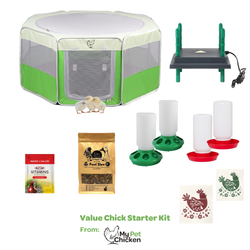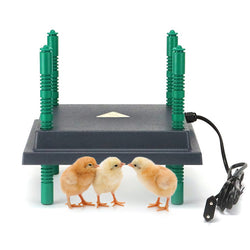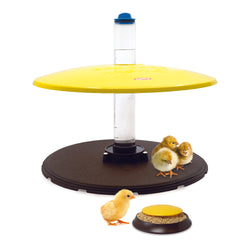Brahma Chicken Breed: The Ultimate Guide
Back to blog
The Brahma chicken breed has taken the poultry world by storm due to their large size and docile nature. Join us as we explore the origins, characteristics, and care of Brahmas. Whether you're considering adding Brahmas to your flock or simply want to deepen your knowledge about these beloved chickens, this blog is your go-to resource.
History of the Brahma chicken breed
The Brahma chicken breed, also known as the "King of Chickens," traces its roots back to the United States in the mid-19th century. Developed in the United States from large fowl imported from China, the breed quickly gained popularity for its remarkable size and striking appearance. The first documented Brahmas were created by crossing Shanghai and Chittagong breeds with the intention of producing a superior meat bird.
The Brahma breed officially gained recognition in the American Poultry Association (APA) Standard of Perfection in 1874. The APA acknowledged three varieties of Brahmas at the time: Light, Dark, and Buff.
My Pet Chicken offers these Brahma chickens for sale:
The personality of a Brahma chicken
Brahma chickens are known for their delightful and friendly personalities. The breed's gentle giant temperament has also contributed to its popularity among poultry keepers, earning it a reputation as an excellent choice for backyard flocks.
Their easygoing nature extends to their interactions with other chickens. Brahmas are known for their tolerance and patience, making them well-suited for multi-breed flocks. They tend to avoid conflicts and can act as peacemakers within the coop.
Overall, Brahmas make wonderful additions to a backyard flock due to their friendly and easygoing nature. Their engaging personalities and calm demeanor make them delightful companions, whether you're a seasoned chicken keeper or new to raising poultry.
The appearance of Brahma chickens
Each variety boasts distinctive plumage patterns. The Light Brahmas display a striking contrast of black and white feathers. Dark Brahmas have a more subdued black and white coloration, and the Buff Brahma showcasing a warm buff color.
On average, a mature Brahma hen can weigh between 9 to 10 pounds. Roosters tend to be slightly heavier, weighing 12 pounds. These weights are approximate and can vary depending on factors such as diet, overall health, and individual genetics.
Egg color and production of Brahma chickens
Brahmas can produce around 150-200 brown eggs per year and can be good winter layers. This can vary depending on factors such as their diet and environment. They typically start laying eggs at around 6-9 months of age.
Care and health for Brahma chickens
Brahma chickens are hardy in cold weather but may have a difficult time in hot climates due to their large size. With proper care and attention, they can live healthy and productive lives, laying colorful and abundant eggs for years to come. The average life span of this chicken breed is 5-8 years.
Do you have any Brahama chickens in your flock? Share with us in the comments below.
Ready to grow your flock? Discover all our day-old baby chicks and choose your perfect match.






10 comments
Is it okay if I cage my brahma?
———
My Pet Chicken replied:
If you’re asking whether it’s okay to keep your Brahma in a cage, the answer depends on the situation. For short-term use—like transport, injury recovery, or brief quarantine—a cage can be fine if it’s well-ventilated, clean, and allows the bird to stand and turn comfortably.
However, long-term confinement in a small cage isn’t recommended. Brahmas are large, gentle birds that need plenty of space to move, stretch, and stay healthy. Ideally, they should have 4–5 square feet per bird in the coop and at least 10 square feet per bird in the run. Without room to roam, they’re more prone to stress, boredom, and health issues.
If free-ranging isn’t an option, a secure, roomy run or chicken tractor is a better choice than a cage. With the right setup, your Brahma can live a happy, healthy life—and we’re always here to help you design a space that works for both your flock and your backyard.
Do brahmas lay and hatch eggs?
———
My Pet Chicken:
Yes, Brahmas do lay eggs! They are good layers of medium to large brown eggs, averaging around 3-4 eggs per week. While they are not known for being the most prolific layers compared to some breeds, they are steady producers, even in colder months.
As for hatching, Brahmas can go broody, but they are not the most frequent setters. When they do decide to brood, they tend to be dedicated and make great mothers. Their large size allows them to cover a good number of eggs, which can be an advantage if you’re looking to hatch a larger clutch!
I absolutely adore my Brahmas. They are the friendliest most loving birds and their large size makes them less vulnerable. I do keep black copper marans with them because predatory birds think they are crows and stay away.
———
My Pet Chicken:
It’s wonderful to hear how much you adore your Brahmas! They really are gentle giants with a friendly and big personality. Pairing them with Black Copper Marans or other black feathered birds as a natural predator deterrent is such a clever strategy! Those dark feathers definitely can make hawks think twice.
Sounds like you have a well-thought-out, happy, and safe flock. Thanks for sharing your experience!
I started with a Light Brahma chick I picked up on clearance at a local farm store. I almost put her back, because it wasn’t one of the breeds I had originally planned on getting. I’m so glad I brought her home! She is the sweetest girl! If you want a lap chicken..get a Brahma!
I have since added a Dark Brahma, and 2 Buff Brahma bantams. All four of them have the same calm, friendly, lovable demeanor!
———
My Pet Chicken:
What a sweet story! Brahmas really are such gentle, lovable birds, and it’s wonderful to hear how much you enjoy your flock. Taking a chance on your Light Brahma sure paid off! Your Dark Brahma and Buff bantams sound just as delightful. Thanks for sharing!
How can I get this specie in Nepal??
———
My Pet Chicken:
Unfortunately, we don’t currently ship to Nepal, but there are still ways you can get the breed you’re looking for. I recommend connecting with local poultry breeders or farms in your area that may specialize in rare breeds. Additionally, online poultry communities and forums can be a great resource for finding breeders